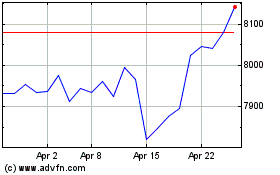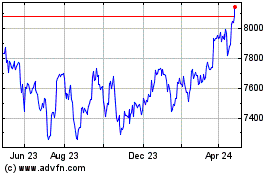By Barbara Kollmeyer and Anora Mahmudova, MarketWatch
Nasdaq finishes at second highest close
U.S. stocks closed higher Friday to score fresh records,
following a mixed batch of corporate bank results and poor data on
retail-sales and inflation, which led market participants to
believe the Federal Reserve is firmly back in a dovish frame of
mind.
The Dow Jones Industrial Average rose 84.65 points, or 0.4% to
finish at 21,637.74, its third record close in a row, and the 25th
record close for the average this year. The blue-chip average was
led higher by gains for Wal-Mart Stores Inc.(WMT) and Microsoft
Corp.(MSFT) and Intel Corp.(INTC). Shares of J.P. Morgan Chase
& Co. (JPM) and Goldman Sachs Group Inc. (GS) were the worst
performers on the average.
The S&P 500 index rose 11.44 points, or 0.5%, to finish at a
record 2,459.27, its first record close since June 19. All sectors
except financials finished in positive territory. Real estate and
tech shares finished up 1.1% and 0.9%, respectively.
The Nasdaq Composite Index gained 38.03 points, or 0.6%, to
close at 6,312.47, for its sixth-straight positive close. The index
finished just shy of its closing record of 6,321.76 set on June
8.
For the week, the main equity indexes posted solid gains, led by
a 2.6% rise for the Nasdaq, a 1.4% gain for the S&P 500 and a
1% climb for the Dow.
Additionally, the Dow Jones Transportation Average , the Russell
2000 and the Russell 1000 closed at records Friday.
Advances on Wall Street follow weaker-than-expected economic
releases. Inflation was flat
(http://www.marketwatch.com/story/inflation-goes-nowhere-in-june-cpi-shows-2017-07-14)
in June, while a reading of retail sales slumped
(http://www.marketwatch.com/story/us-retail-sales-fizzle-out-in-june-2017-06-14),
emphasizing persistent weakness in that sector and underlining
consumer reluctance to spend. The patch of data raises some
questions about the Federal Reserve's ability to quickly normalize
monetary policy, as it hopes to do, despite signs of anemic growth
and stubbornly low inflation.
"I think this morning's economic data once again plays into the
narrative that the Fed will be more dovish," said Ian Winer, head
of the equities division at Wedbush Securities, in an interview.
"It further fuels the sentiment that there's no alternative for
stocks."
With weak inflation and less hard data pointing to growth, Winer
said the Fed is more likely to think twice about raising rates and
may even postpone an expected reduction of the $4.5 trillion
balance sheet in September.
"Economic surprises continue to tilt toward the downside in the
world's largest economy, suggesting that the Federal Reserve's
hawkish stance earlier in the year could once again prove
ill-founded," said Karl Schamotta, market strategist at Cambridge
Global Payments.
"Market participants are increasingly convinced that the central
bank's 'dot plot' rate forecast will be adjusted downward, with the
yield curve coming under pressure as investors fade the likelihood
of rapid monetary tightening," Schamotta said.
The so-called dot plot refers to a graph of Fed member
expectations for rates into the future, while the yield curve is a
line that charts yields across every available maturity. A
flattening yield curve, showing a narrowing premium between
short-dated yields and long-dated Treasurys, has traditionally been
viewed as a sign that investors are bearish on economic
prospects.
Need to Know:Here's a quirkier game plan for markets that are
'priced for perfection'
(http://www.marketwatch.com/story/heres-a-quirkier-game-plan-for-markets-that-are-priced-for-perfection-2017-07-14)
The lackluster economic data led to a drop in 10-year Treasury
yields , meaning investors bought notes. Treasury yields fell to
2.28% at one point and currently stand at 2.32%. Bond prices and
yields move inversely.
Stocks to watch: J.P. Morgan (JPM) beat expectations on both
revenue and profit, but shares gave up an early initial gain to
close 0.9% lower.
Citigroup Inc.(C) reported earnings that were better than
expected
(http://www.marketwatch.com/story/citigroup-tops-profit-and-revenue-estimates-2017-07-14),
but it did show signs of a slowdown in trading, with overall
trading revenue down 4% and fixed-income trading revenue off 6%.
Shares of the bank closed 0.5% lower.
Wells Fargo & Co.(WFC) reported second-quarter results that
were better than expected but shares fell 1.1%.
Ahead of those results, Wall Street had been expecting banks to
deliver a weak quarter, potentially kicking off the latest in a
string of disappointing earnings seasons
(http://www.marketwatch.com/story/bank-earnings-expect-another-meh-quarter-of-weak-trading-revenue-2017-07-10).
The shine has come off the sector as hopes have faded that
President Donald Trump will push through structural reforms and
boost the economy. Disappointment from banks could weigh on the
broader market, warned some.
CyberArk Software Ltd.(CYBR) shares dropped 16% after the
cybersecurity firm reported weaker-than-expected earnings, weighing
upon other computer security shares
(http://www.marketwatch.com/story/security-stocks-hit-as-cyberark-hints-that-ransomware-scares-didnt-drive-business-2017-07-14).
Read:Four key sectors to watch closely this earnings season
(http://www.marketwatch.com/story/four-key-sectors-to-watch-closely-this-earnings-season-2017-07-13)
(http://www.marketwatch.com/story/four-key-sectors-to-watch-closely-this-earnings-season-2017-07-13)Other
markets: In Asia , markets ended the day with modest gains.
European stocks
(http://www.marketwatch.com/story/european-stocks-waver-but-best-week-in-two-months-in-sight-2017-07-14)
finished mostly lower even though the Stoxx Europe 600 posted a
slight gain for its best week in two months. A stronger British
pound was weighing on the FTSE 100
(http://www.marketwatch.com/story/stronger-pound-holds-ftse-100-back-for-2nd-day-2017-07-14)
for a second day.
Crude-oil prices
(http://www.marketwatch.com/story/oil-gains-pause-but-optimism-remains-after-iea-report-2017-07-14)
settled up 1% at $46.54 for a 5.2% weekly gain, while gold
(http://www.marketwatch.com/story/gold-snaps-back-tracking-weekly-rise-even-with-stocks-holding-near-records-2017-07-14)
rose 0.8% to settle at $1,227.50 an ounce for a 1.5% weekly
gain.
The dollar followed interest rates lower after disappointing
retail sales with the ICE Dollar index falling 0.6% to 95.11, its
lowest level in 10 months.
Read:Saudi Arabia's worst-case oil scenario might surprise you
()
--Barbara Kollmeyer in Madrid contributed to this article.
(END) Dow Jones Newswires
July 14, 2017 16:27 ET (20:27 GMT)
Copyright (c) 2017 Dow Jones & Company, Inc.
FTSE 100
Index Chart
From Mar 2024 to Apr 2024

FTSE 100
Index Chart
From Apr 2023 to Apr 2024
